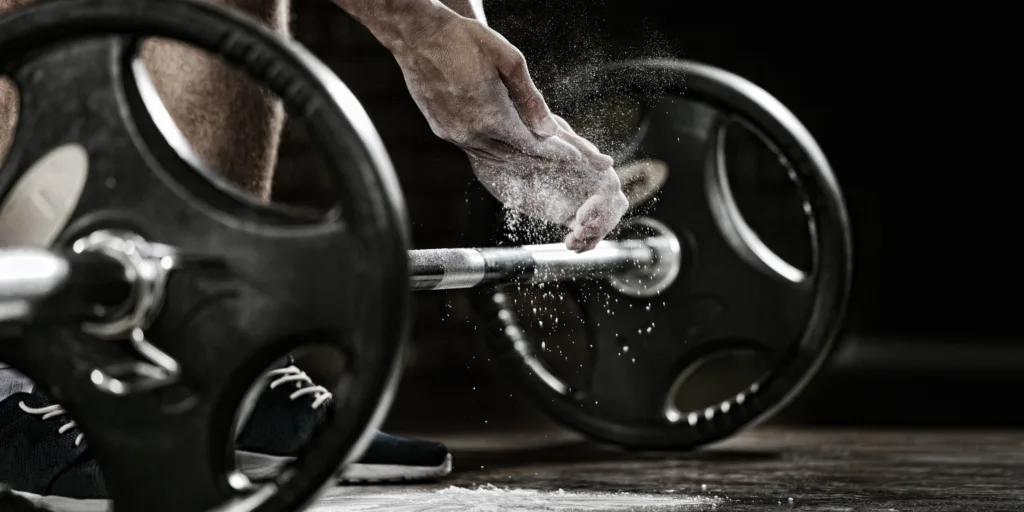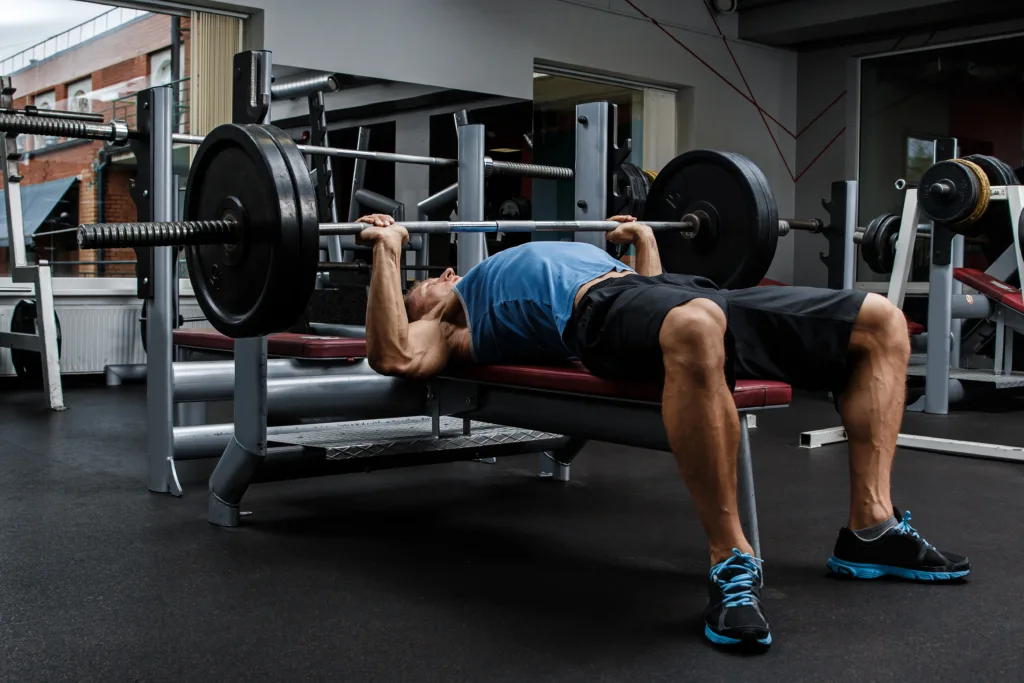Contents
- Introduction
- What are cluster sets?
- What are cluster sets used for?
- Do cluster sets work?
- How to perform cluster sets work
- What is a cluster set example?
- How many cluster sets per exercise?
- What is the difference between cluster sets and myo sets?
- Conclusion
Introduction
Cluster sets are a strategy used in weight training to preserve the velocity of an exercise across a series of repetitions (i.e., a ‘set’). This allows power output and overall quality of exercise execution to be sustained over the course of a set by interspersing brief stints of rest between individual repetitions or ‘clusters’ (2-5) of repetitions (15).
Cluster sets potentially allow for exercises (e.g. squat, bench press, power clean) to be completed at higher intensities (heavier loads relative to 1-repetition maximum). Due to the intraset rest, implementing cluster sets helps to promote maximal intent for each repetition due to the conservation of fatigue by avoiding extended sets (typically nothing beyond ~ 5 repetitions, (1)). Due to the opportunities allowed with cluster sets, research has shown that this method can be a viable training strategy to enhance strength, power, and hypertrophy (15).
What are cluster sets?
Cluster sets are a term used to describe the restructuring of a traditional set that allows for increased performance (15). Rather than performing continuous repetitions for a given set, there is an incomplete rest period allowed during the set (intraset) that minimises the fatigue associated with a more extensive, ‘traditional set’ performed in succession.
Although research supports the benefits of increased time under tension found with traditional sets (2). Specifically, muscular hypertrophy and strength are increased through traditional straight sets (e.g. repetitions performed to fatigue, experiencing the systemic build-up of metabolites and degradation of movement velocity (9).
However, other research has suggested that performing faster velocity-concentric movements can promote greater increases in strength and hypertrophy than slower velocities (13) and training to failure is not required in order to build maximal strength (5).
One thing to appreciate about cluster sets is that time spent training will increase as well. Cluster sets should not be confused with ‘rest redistribution,’ which is a training method that instead of taking a full 2-3-min break between traditional sets, the interest rest is reduced (e.g. 60-90-sec) and the time saved is interspersed intraset to help maintain quality. Although nuanced, cluster sets are not a form of rest redistribution.

What are cluster sets used for?
Cluster sets are used as a means of maintaining higher quality outputs (e.g. movement velocity) with higher relative intensities. By doing this an individual is able to possibly operate at a higher volume load, which provides potential training and performance adaptations (15).
Additionally, cluster sets can be used as a means of minimising fatigue and decreasing the perception of effort by limiting the extended duration of a set and avoiding performance (e.g. velocity) decrement across repetitions by increasing the rest taken intraset.
Do cluster sets work?
Cluster sets have shown to be equally as beneficial as traditional sets in the acute form. Performing cluster sets reduces the perception of effort, mechanical, and metabolic fatigue compared to traditional sets (8). However, as far as long-term, chronic adaptations (e.g. following 8 weeks of training), there is no significant benefit in using cluster sets when compared to traditional sets (4).
There are numerous examples in research that display the ability to maintain a greater average velocity for repetitions broken into ‘clusters’ of 1-5 reps (4), with 15-30-sec of rest (8), performing cluster sets of two repetitions (versus 4-5 repetitions) resulting in greater average force, total work, and time under tension, while maintaining power and velocity outputs (15). This is also seen with jumping performance during squat jumps, where ten sets of two repetitions outperformed two sets of ten in power, take-off velocity, and jump height (11). Ultimately, cluster sets are a strategy that has proven to allow for greater velocity and power compared to traditional sets (3).
How to perform cluster sets
A basic cluster set is accomplished by performing 1-5 repetitions with maximal effort (e.g. back squat). The athlete then racks the bar and steps out from underneath to passively rest for 15-40 seconds before getting back under the bar, unracking, and repeating an additional 1-5 repetitions with maximal effort. Some research suggests resting >20-sec, but that depends on the exercise (e.g. power clean) (10). This can be repeated as long as quality and performance output remain. Importantly, there is still a full rest period of 2-3 minutes between sets to allow for recovery and performance of multiple sets.
What is a cluster set example?
Instead of performing traditional sets of ten repetitions (i.e. 3×10) with 90 seconds of rest between each set, an individual can perform ten sets of three repetitions with 20 seconds of rest between each set. When compared, both strategies saw increases in strength, balance, and endurance, but the cluster set strategy was accomplished with a lower perception of effort (14)
How many cluster sets per exercise?
Based on a recent systematic review and meta-analysis, total sets can be anywhere from one to ten, with total repetitions accumulated in a set stopping within 8-12 repetitions (3). Ultimately, the goal of cluster sets is to maintain quality. Therefore, terminating activity when a degradation (e.g. 10-20%) of performance (e.g. velocity) occurs is important to minimise fatigue.

What is the difference between cluster sets and myo sets?
Although the literature has yet to consistently define specifically what a cluster set is (15), it is generally agreed upon that a cluster set is done to maximise the velocity of a given exercise by interspersing intraset rest periods (avoiding failure and mitigating fatigue). Whereas myo reps are a form of ‘rest-pause’ training and are generally done to failure (or near failure) in order to maximise hypertrophy (6).
Myo reps are used as a time-efficient strategy that aims to maximise ‘effective repetitions’ at the end of a traditional set, which have a close proximity to failure. The thought process around utilising myo reps is to maximise muscle fibre recruitment through incomplete rest and accumulate more repetitions under fatigue. Research has found that ‘rest-pause’ training can promote greater gains in strength, but similar hypertrophy compared to traditional sets (6).
A typical myo rep set would involve a series of repetitions (a set) that is to or just shy (1-2 repetitions) of failure, followed by a 20-30-sec rest period and then an additional 2-5 repetitions are performed. This process is repeated until the individual can no longer achieve the additional 2-5 repetitions (failure).
Conclusion
Cluster sets are arguably no better than traditional sets, but in the right context, they can be a viable strategy that helps an individual maximise their training efforts. For example, cluster sets could be a great strategy for an in-season athlete who is aiming to minimise fatigue, yet maximise performance and operate with high relative intensity (e.g. 80-90%-1-repetition maximum (4)). This training strategy can help to develop the necessary strength, power, and muscle mass helpful in enhancing sports performance.
Ultimately, with cluster sets, quality is the key, allowing athletes to perform well and avoid digging too deep into the fatigue and failure space. By doing this, training can be more enjoyable and possibly more productive than traditional sets. All in all, context is king, clusters have their time and place. Which inevitably depends on multiple factors (e.g. training goals, the time of year, the exercise itself, practicality, an athlete’s training history, etc.). Cluster sets have potential but need to be used appropriately to be most effective.
- Api, G., Legnani, R. F. D. S., Foschiera, D. B., Clemente, F. M., & Legnani, E. (2023). Influence of Cluster Sets on Mechanical and Perceptual Variables in Adolescent Athletes. International Journal of Environmental Research and Public Health, 20(4), 2810. [Link]
- Burd, N. A., Andrews, R. J., West, D. W., Little, J. P., Cochran, A. J., Hector, A. J., Cashaback, J. G., Gibala, M. J., Potvin, J. R., Baker, S. K., & Phillips, S. M. (2012). Muscle time under tension during resistance exercise stimulates differential muscle protein sub-fractional synthetic responses in men. The Journal of physiology, 590(2), 351–362. [Link]
- Davies, T. B., Tran, D. L., Hogan, C. M., Haff, G. G., & Latella, C. (2021). Chronic effects of altering resistance training set configurations using cluster sets: a systematic review and meta-analysis. Sports Medicine, 51, 707-736. [Link]
- Davies, T. B., Halaki, M., Orr, R., Helms, E. R., & Hackett, D. A. (2020). Changes in bench press velocity and power after 8 weeks of high-load cluster-or traditional-set structures. The Journal of Strength & Conditioning Research, 34(10), 2734-2742. [Link]
- Drinkwater, E. J., Lawton, T. W., Mckenna, M. J., Lindsell, R. P., Hunt, P. H., & Pyne, D. B. (2007). Increased number of forced repetitions does not enhance strength development with resistance training. The Journal of Strength & Conditioning Research, 21(3), 841-847. [Link]
- Enes, A., Alves, R. C., Schoenfeld, B. J., Oneda, G., Perin, S. C., Trindade, T. B., Prestes, J., & Souza-Junior, T. P. (2021). Rest-pause and drop-set training elicit similar strength and hypertrophy adaptations compared with traditional sets in resistance-trained males. Applied Physiology, Nutrition, and Metabolism, 46(11), 1417-1424. [Link]
- González-Badillo, J. J., Rodríguez-Rosell, D., Sánchez-Medina, L., Gorostiaga, E. M., & Pareja-Blanco, F. (2014). Maximal intended velocity training induces greater gains in bench press performance than deliberately slower half-velocity training. European journal of sport science, 14(8), 772-781. [Link]
- González-Hernández, J. M., García-Ramos, A., Castaño-Zambudio, A., Capelo-Ramírez, F., Marquez, G., Boullosa, D., & Jiménez-Reyes, P. (2020). Mechanical, metabolic, and perceptual acute responses to different set configurations in full squat. The Journal of Strength & Conditioning Research, 34(6), 1581-1590. [Link]
- Gorostiaga, E. M., Navarro-Amezqueta, I., Calbet, J. A., Hellsten, Y., Cusso, R., Guerrero, M., … & Izquierdo, M. (2012). Energy metabolism during repeated sets of leg press exercise leading to failure or not. PloS one, 7(7), e40621. [Link]
- Hardee, J. P., Lawrence, M. M., Zwetsloot, K. A., Triplett, N. T., Utter, A. C., & McBride, J. M. (2013). Effect of cluster set configurations on power clean technique. Journal of sports sciences, 31(5), 488-496. [Link]
- Moreno, S. (2012). Effect of cluster sets on plyometric jump power. California State University, Fullerton. [Link]
- Oliver, J. M., Kreutzer, A., Jenke, S. C., Phillips, M. D., Mitchell, J. B., & Jones, M. T. (2016). Velocity drives greater power observed during back squat using cluster sets. The Journal of Strength & Conditioning Research, 30(1), 235-243. [Link]
- Pareja-Blanco, F., Rodríguez-Rosell, D., Sánchez-Medina, L., Gorostiaga, E. M., & González-Badillo, J. J. (2014). Effect of movement velocity during resistance training on neuromuscular performance. International journal of sports medicine, 916-924. [Link]
- Rappelt, L., Held, S., Leicht, M., Wicker, P., & Donath, L. (2022). Similar strength gains at lower perceived efforts via cluster set vs. traditional home-based online training: A 6 weeks randomized controlled trial. Frontiers in Sports and Active Living, 4, 968258. [Link]
- Tufano, J. J., Brown, L. E., & Haff, G. G. (2017). Theoretical and practical aspects of different cluster set structures: a systematic review. Journal of strength and conditioning research, 31(3), 848-867. [Link]




